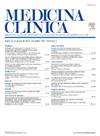溶栓治疗对老年癌症合并大面积肺栓塞患者死亡率的影响
IF 2.1
4区 医学
Q1 MEDICINE, GENERAL & INTERNAL
引用次数: 0
摘要
大规模肺栓塞(MPE)与高死亡率相关,尤其是65岁及以上的癌症患者。溶栓治疗(TT)是一种挽救肺栓塞生命的干预措施,但其在这一脆弱人群中的有效性和安全性仍不确定。本研究旨在评估溶栓治疗对诊断为MPE的老年癌症患者死亡率的影响。材料和方法本回顾性研究纳入90例年龄≥65岁的MPE患者。根据患者的恶性程度和TT的使用情况进行分类。比较临床、实验室和超声心动图参数。记录每位患者一个月的全因死亡率。结果恶性肿瘤患者的死亡率高于非恶性肿瘤患者(63.3%比46.7%,p = 0.1),但两组患者的出血率相似。在癌症患者中,TT治疗对死亡率没有显著影响(60%对65%,p = 0.7)。通过右心室收缩运动和TAPSE评估,癌症患者的右心室功能受损更为严重,TT没有导致这些参数的显著改善。结论溶栓治疗不能显著降低老年肿瘤合并大面积肺栓塞患者1个月死亡率。然而,它不会增加出血并发症,这表明它可能是一个可行的选择,为选定的患者。溶栓治疗组和非溶栓治疗组之间相似的死亡率突出了恶性肿瘤、凝血和心血管风险之间复杂的相互作用。这些发现强调了个体化风险评估和治疗决策的必要性。本文章由计算机程序翻译,如有差异,请以英文原文为准。
Effect of thrombolytic therapy in mortality of elderly patients with cancer and massive pulmonary embolism
Introduction
Massive pulmonary embolism (MPE) is associated with high mortality, particularly in cancer patients aged 65 years and older. Thrombolytic therapy (TT) is a life-saving intervention in pulmonary embolism, yet its efficacy and safety in this vulnerable population remain uncertain. This study aimed to evaluate the impact of thrombolytic therapy on mortality in elderly cancer patients diagnosed with MPE.
Materials and methods
This retrospective study included 90 patients aged ≥ 65 years diagnosed with MPE. Patients were categorized based on malignancy status and administration of TT. Clinical, laboratory, and echocardiographic parameters were compared. One-month all-cause mortality was recorded for each patient.
Results
Patients with malignancy exhibited higher mortality rates compared to non-malignant cases (63.3% vs. 46.7%, p = 0.1), though bleeding rates were similar between the two groups. Among cancer patients, the administration of TT did not significantly affect mortality (60% vs. 65%, p = 0.7). Right ventricular function, assessed by RV systolic motion and TAPSE, was more severely impaired in cancer patients, and TT did not lead to significant improvement in these parameters.
Conclusion
Thrombolytic therapy in elderly cancer patients with massive pulmonary embolism does not significantly reduce 1-month mortality. However, it does not increase bleeding complications, suggesting that it may be a viable option for selected patients. The similar mortality rates between thrombolytic therapy and non-thrombolytic therapy groups highlight the complex interplay between malignancy, coagulation, and cardiovascular risk. These findings emphasize the need for individualized risk assessment and treatment decisions.
求助全文
通过发布文献求助,成功后即可免费获取论文全文。
去求助
来源期刊

Medicina Clinica
医学-医学:内科
CiteScore
3.10
自引率
5.10%
发文量
295
审稿时长
22 days
期刊介绍:
Medicina Clínica, fundada en 1943, es una publicación quincenal dedicada a la promoción de la investigación y de la práctica clínica entre los especialistas de la medicina interna, así como otras especialidades. Son características fundamentales de esta publicación el rigor científico y metodológico de sus artículos, la actualidad de los temas y, sobre todo, su sentido práctico, buscando siempre que la información sea de la mayor utilidad en la práctica clínica.
 求助内容:
求助内容: 应助结果提醒方式:
应助结果提醒方式:


